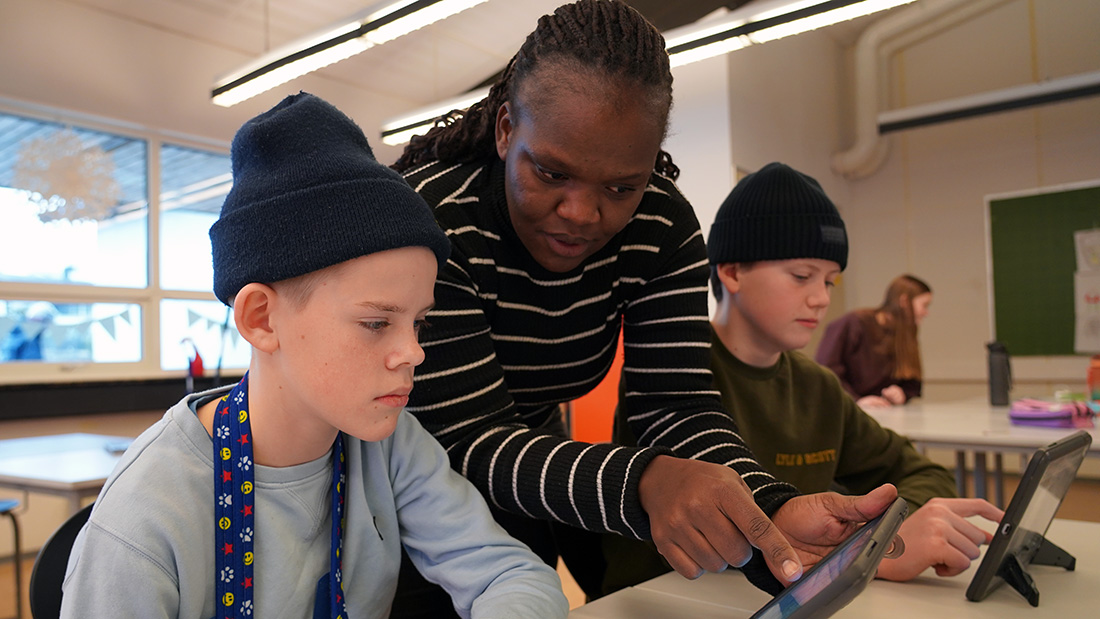– I wanted to learn about the school system in Norway and compare it to the system back home in Namibia regarding classroom teaching and how teachers teach here. So far, this has been a good experience for us, says Aalliyah M.H. Eichas.
Spending five weeks in Hamar
Along with Meloline Herunga, she studies teachereducation on a daily basis at the University of Namibia. Before their stay in Norway, they had never been outside the country, so there are a lot of new experiences to take in. They had to get passports for the long journey and have experienced a completely different climate, but more importantly, they have had the opportunity to practise as teachers in a completely different culture before they complete their teacher training next year.

There are significant differences between Namibia and Norway in terms of culture. In Namibia, there are shorter breaks between classes and less time for physical activities, while according to the students, students in Norway have more freedom at school. Additionally, teaching in Namibia has a slightly more lecture-based style. Another significant difference is that each teacher in Namibia teaches far more students.
– In Namibia, a teacher is responsible for a class of up to 40-45 students, while in Norway, there are three to four teachers for classes with about 20 students, says Eichas.
– Here, the students also move around much more in the classroom than at home in Namibia, which means that teaching can be structured in slightly different ways, says Herunga.

They have worked together with two Norwegian students at Prestrud Primary school, Solveig Brusdal Hamstad and Martine Kjølby, who are studying primary school teacher education for grades 1-7. Working together with two students from another country is also valuable for the two norwegian students.
– It has been fun and educational. They come from a completely different culture, so it has been nice to show them the school culture in Norway, but also to give them an insight into what it's like to live in Norway, says Brusdal Hamstad.
The internationalization project "Multicultural Practicum Groups and Internationalisation in Teacher Education" has ensured that Aalliyah and Meloline have been able to come to Hamar. The project is funded by the Norwegian Directorate for Higher Education and Competence through the Norwegian Partnership Programme for International Teacher Education. In 2018, Inland Norway University of Applied Sciences applied for this project. What was initially a four-year project has been extended to six years due to delays caused by the pandemic and will be completed this summer.
In total, ten students from the University of Namibia have, thanks to the project, spent a five-week period in Hamar, while an equal number of HINN students have had a similar practical training period at one of the University of Namibia's partner schools in the capital, Windhoek.
– We get their perspectives on teaching in Norway, which is valuable. Even though we're not currently teaching in another country, the feedback from the Namibian students can open our eyes to how we teach here, since we do it in slightly different ways, says Brusdal Hamstad.
At the moment, there are four Namibian students here, two in practice at Prestrud Primary School and two at Rollsløkken Primary School.
– We have, among other things, presented how Easter is celebrated in Namibia. March 21st is Namibia's Independence Day, and then we will give the students an insight into the country's history and liberation, says Eichas and Herunga.
– Valuable with internationalization of teacher education
Project leader Knut Øystein Høvik believes that internationalization of teacher education has great value for both Norwegian and Namibian students.
– This is the first time we've welcomed students from Namibia, and the feedback suggests that the students have had good chemistry and a rewarding collaboration. Our outgoing students and the incoming students from Namibia have completed preparatory courses, and there is no doubt that they have learned a lot during these weeks, says Høvik.

The opportunity to go on exchange to countries like Namibia has been something that has attracted teacher students to Hamar over the years, but not everyone has the time or finances to carry out such exchange stays. Høvik believes that practical training like this is a form of internationalization at home in Hamar.
– Our students gain intercultural competence and valuable experiences here in Hamar. We see that the Norwegian school system is also becoming more international with multicultural classes, so this is relevant for the profession they will enter in a few years, says Høvik.
– All experiences teachers gain in practice are useful. As teachers, we use many examples in our teaching, and the opportunity to have a practical period with two students from Namibia gives us examples we can benefit from, says Brusdal Hamstad and Kjølby.



